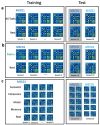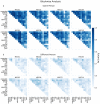Masked features of task states found in individual brain networks
- PMID: 35802477
- PMCID: PMC10016040
- DOI: 10.1093/cercor/bhac247
Masked features of task states found in individual brain networks
Abstract
Completing complex tasks requires that we flexibly integrate information across brain areas. While studies have shown how functional networks are altered during different tasks, this work has generally focused on a cross-subject approach, emphasizing features that are common across people. Here we used extended sampling "precision" fMRI data to test the extent to which task states generalize across people or are individually specific. We trained classifiers to decode state using functional network data in single-person datasets across 5 diverse task states. Classifiers were then tested on either independent data from the same person or new individuals. Individualized classifiers were able to generalize to new participants. However, classification performance was significantly higher within a person, a pattern consistent across model types, people, tasks, feature subsets, and even for decoding very similar task conditions. Notably, these findings also replicated in a new independent dataset. These results suggest that individual-focused approaches can uncover robust features of brain states, including features obscured in cross-subject analyses. Individual-focused approaches have the potential to deepen our understanding of brain interactions during complex cognition.
Keywords: BOLD fMRI; functional connectivity; individual differences; machine learning; task states.
© The Author(s) 2022. Published by Oxford University Press. All rights reserved. For permissions, please e-mail: journals.permissions@oup.com.
Figures







References
-
- Ambekar A, Ward C, Mohammed J, Male S, Skiena S. 2009. Name-ethnicity classification from open sources. In: Proceedings of the 15th ACM SIGKDD international conference on Knowledge discovery and data mining - KDD ‘09. Paris, France: ACM Press. p. 49. [accessed 2021 May 12]. http://portal.acm.org/citation.cfm?doid=1557019.1557032.
Publication types
MeSH terms
Grants and funding
LinkOut - more resources
Full Text Sources

